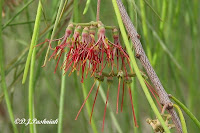Yesterday the predicted cold weather arrived from down south. Before the sun rose there was even a touch of frost on some dry grass next door. When the sun got up high enough to warm things up a little, every bird in the neighbourhood seemed to want to comment on conditions.
The Rainbow Lorikeets were around and as noisy as they usually are. I heard Noisy Friarbirds and had a brief look at some Spangled Drongos before they flew off. The Figbirds were making a lot of noise in both the big pine tree next door and also out on the power lines beside the road.
Male Figbird

A juvenile Pied Butcherbird joined the group on the wire.
The noisiest of all were the Blue-faced Honeyeaters. One juvenile, especially, sat and simply screamed for some adult to come and feed it. As soon as it had been fed it started the same noisy behavior again.
Juvenile Blue-faced Honeyeater

Blue-faced Honeyeater

A Kookaburra was sitting in the big pine tree next door and apparently objected to the noise. It hopped closer to the noisiest youngster in the tree – and was immediately mobbed by a whole group of birds until it flew off with a disgusted squawk. The Blue-faced Honeyeaters are such aggressive birds. I have frequently seen them mobbing and chasing off both cats and dogs.
Kookaburra

































